
A PRIMER OF MODERN STANDARD HINDI
Book Specification
| Item Code: | IDD446 |
| Author: | Michael C. Shapiro |
| Publisher: | Motilal Banarsidass Publishers Pvt. Ltd. |
| Language: | Hindi |
| Edition: | 2014 |
| ISBN: | 9788120805088 |
| Pages: | 309 |
| Cover: | Paperback |
| Other Details | 9.4" X 7.2" |
| Weight | 550 gm |
Book Description
This primer presents a systematic introduction to the structure of Modern Standard Hindi. It is intended to provide the student with a through foundation in the grammatical structure of that variety of Hindi that is commonly taught in Indian schools and that is the common vehicle of publication in Hindi. Although much emphasis is placed on the written language, discussion is also provided of aspects of conversational Hindi.
The core of the work contains thirty-one chapters. The first four offers discussions of the linguistic status of Hindi as well as comprehensive description of Hindi phonetics and the Devanagari syllabary in which Hindi is written. Chapter 5 through 31 each contains description of fundamental aspects of Hindi grammar. These chapters have extensive translation and grammatical exercises appended to them. The work as a whole introduces a core vocabulary of approximately fifteen hundred entries, incorporating lexical items found on most standard elementary word lists for the language.
Supplemental materials in this book include graded reading passages, a guide to further study in Hindi, and Hindi English glossary. Although the Devanagari syllabary is used throughout the book, Roman transliteration is also provided through Chapter 15.
A Primer of Modern Standard Hindi can be used in several different ways. It can be used as part of a university-level course as a text for Hindi grammar and writing. As such it will nicely supplement other materials addressing more conversational aspects of the language. It can also be used for self- study purposes by the student who does not have access to a formal instructional program.
About the Author:
Michael C. Shapiro is Associate Professor of Indian Languages and Literature at the University of Washington (Seattle, USA). He is the author of Language and Society in South Asia (with Harold F. Schiffman, MLBD Studies in Linguistics, Vol. 1), Current Trends in Hindi Syntax: A Bibliographic Survey (Studien zur Indologieund Iranistik, Monographic 5), and many studies in Hindi language, linguistic, and literature
This book arises from a sense of dissatisfaction with the teaching materials that are available for the Hindi language. Those materials written during the past three decades, particularly those published in the United States, have concentrated almost exclusively on the inculcation of oral skills in Hindi. Inadequate attention has been given to formal grammar, reading, and writing. It has been my experience that as a result of this emphasis, many students of Hindi in the United States have been seriously deficient in basic literacy skills. Other Hindi instructors with whom I am acquainted like- wise have decried the lack of emphasis on written skills in available language courses, grammars, and the like. There has been a growing sentiment among Hindi teachers that instruction in the language should effect a more even balance among reading, writing, and speaking skills than it currently does.
The title I have selected for this book, A Primer of Modern Standard Hindi, has a decidedly old-fashioned ring to it. This is by intention. The book is a primer, that is, a systematic introduction to its topic. Subjects have been included and arranged on the basis of pedagogical efficacy. The work presupposes no prior knowledge of Hindi or its writing system. Moreover, this is a primer of standard, as opposed to colloquial, Hindi. It tries to impart knowledge of that style of Hindi that is taught in Indian schools and that is used in the various Indian media. The book is not a manual of colloquial Hindi. For that, other materials are readily available. This is not to say that much of what is said in this book about formal Hindi is not applicable to the structure of the conversational language. On the contrary, there is a considerable degree of overlap between the two styles or registers of the language and many of the peculiarities and idiosyncrasies of the colloquial language cannot be explained except in reference to the structures of standard written Hindi. But in the end the imparting of literacy skills and the developing of speaking skills in Hindi are enterprises sufficiently different from one another to warrant that they be accomplished by different techniques and in con- junction with different materials.
In writing a book such as this it is difficult to know what to include and what to leave out. My overriding concern has been to include all of the "nuts and bolts" of Hindi grammar that I believe a student needs to master during the first two years of a college level instructional program. The specific points of grammar that have been treated in this work are, for the most part, those recommended in a recent three-year curriculum for the Hindi language} In addition, I have included a core vocabulary, distributed across the various chapters, of approximately fifteen hundred items. These items have been chosen after examining several published core vocabularies for Hindi. The sequencing of grammatical information in this book is in accordance with my own preferences and teaching practices. I have not aimed for an exhaustive treatment of Hindi grammar in this work—such would be appropriate in a comprehensive reference grammar-, but rather for a systematic and logical exposition of those aspects of the language whose mastery is essential for the development of basic literacy skills.
A Primer of Modern Standard Hindi consists of 31 chapters divided into six parts. Part I (Chapters 1-4) provides some general information about the Hindi language and describes the language’s sounds and writing system. The core of the book, Parts II—VI (Chapters 5-31) comprises a step-by-step introduction to the basic grammatical categories and inflections of the language. Each chapter contains discussions of several facets of the language, a vocabulary section containing approximately 50 entries, and a set of written exercises. Hindi forms are given both in the Hindi (or Devanagari) writing system and in Roman transliteration through Part III. The Roman transliteration is eliminated beginning with Part IV. In order to provide the student with samples g of Hindi of greater than sentence length, a set of supplementary reading passages has been included at the end of each of Parts Il through VI. These are graded in order of difficulty and include both prose and poetry texts. The passages have been taken from diverse sources. Many are from children’s readings in use in India. Others are from newspapers, books of riddles, anthologies of children‘s literature, and All India S Secondary Board examination papers in Hindi. Special vocabulary sections have been appended to these reading passages. Following the 31 chapters are two supplements that should be of assistance to the students. These are a Guide To Further Study of Hindi and a Hindi-English Glossary.
1.1. THE HINDI LANGUAGE
Hindi is one of the most widely spoken languages of the world, possessing speakers of the same order of magnitude as those of English and Russian. In India it has been accorded the status of 'Official Language' and, along with English, is recognized by the central government for use for most administrative purposes. It is spoken natively by at least 150 million persons in the Indian states of Uttar Pradesh, Madhya Pradesh, and Bihar and as a second language by a like number in other states of North India. It is also an official language of Uttar Pradesh, Madhya Pradesh, Bihar, Haryana, Rajasthan, and Himachal Pradesh, as well as of the Delhi union territory. Urdu, a language so closely related to Hindi to allow some to consider the two to be variants of a single tongue, is spoken by tens of millions, either as a first or second language, both in Pakistan and India. Members of emigrant Indian communities the world over use Hindi as a lingua franca. Hindi enjoys some order of official status in countries as diverse as Fiji, Mauritius, and Guyana.
1.2. THE LINGUISTIC STATUS OF HINDI
Hindi belongs to the Indo-Aryan family of languages, a subgroup of the Indo- European family. It is thus related to such European languages as English, French, German, Russian, etc. The modern Indo-Aryan languages, including such standardized literary languages as Bengali, Marathi, Konkani, Panjabi, Assamese, Oriya, Nepali, Sinhala (=Sinhalese), Sindhi, Kashmiri, Urdu, and Hindi, are historically derived from Sanskrit, the most important vehicle of communication of classical Indian civiliza- tion. These modern Indo-Aryan languages stand in approximately the same relation to Sanskrit as do the modern Romance Languages (i.e., French, Spanish, Italian, Portu- guese, Rumanian, etc.) to Latin. With the exception of Sinhala, spoken in Sri Lanka, the Indo-Aryan languages are spread over approximately the northern two-thirds of the Indian subcontinent. Languages of the Dravidian family, genetically unrelated to those of the Indo-Aryan family, are the primary standardized vernaculars of the re- maining third of the subcontinent. The most important of these languages are Tamil, Telugu, Kannada, and Malayalam.
1.3. DIALECTS OF HINDI
In its spoken forms Hindi encompasses a wide range of dialects. Roughly speak- ing, these varieties can be divided into "western" and "eastern" groups, with the former including Braj (western Uttar Pradesh and adjacent districts of Haryana, Rajasthan, and Madhya Pradesh), Bundeli (north-central Madhya Pradesh and south- western Uttar Pradesh), Kanauji (west-central Uttar Pradesh), Bangru (Haryana), western and eastern Hindi dialects, there are several other speech forms that, although counted by some as varieties of Hindi, are properly considered distinct languages. These include a number of Rajasthani languages (of which Marwari is the most widely spoken) and the so-called "Bihari" languages, Maithili, Magahi, and Bhojpuri, of eastern Uttar Pradesh, western and central Bihar, and the Nepal Terai.
The standardized form of Hindi, commonly referred to as khari boli (literally 'standing language'), has a somewhat complex history. Before the end of the nine- teenth century "Hindi" literary works were for the most part written in normalized forms of regional vernaculars. Tulsidas and Surdas, two of Hindi's greatest medieval devotional poets, wrote in old forms of Avadhi and Braj respectively. The modern standard language (as opposed to regional vernacular or literary dialects) arose through the infusion of considerable external (i.e., non-Hindi) vocabulary into a grammatical skeleton based on the vernacular dialect spoken in the Delhi area. Such non-Hindi vocabulary has included forms from such diverse languages as Sanskrit, Arabic, Persian, Turkish, Portuguese, and English. Beginning in the nineteenth century a heavily Sanskritized form of Hindi, often referred to as suddh (or 'pure') Hindi, began to come into existence. It is this form of Hindi, written in the devanagari writing system (v. chaps. 2-4), that has been promulgated by the Government of India and that is taught in formal courses of study in India.
1.4. HINDI,. URDU AND HINDUSTANI
The terms "Urdu" and "Hindustani" are, unfortunately, often used interchange- ably with 'Hindi,' leading to considerable confusion. Urdu, like Hindi, is based on the grammar of the vernacular dialect of the Delhi area. Its vocabulary, however, has been enriched by borrowings from Persian and Arabic. In contrast to Hindi, it is written in a modified form of Arabic script. Whereas devanagari is written from left to right, Urdu is written from right to left. Literary Urdu can differ quite markedly from literary Hindi. In its most formal varieties the former employs a highly Islamicized vocabulary and may also use a limited set of Persian or Arabic grammatical construc- tions. Formal Hindi, by contrast, can be extremely Sanskritized, drawing from the rich technical vocabulary of Sanskrit and employing Sanskrit word building devices such as prefixes, suffixes, and other grammatical markers.
The term Hindustani, easily confusable with Hindi, is used in many different, and often contradictory, senses. The most generally accepted of these is a vernacular speech form that is neither excessively Sanskritized nor Islamicized. Hindustani's vocabulary consists of a core of "native" lexical items, as well as a number of forms drawn from either the Sanskritic or the Perso-Arabic lexica. It is this Hindustani that is employed by the vast majority of either Hindi or Urdu speakers for conversational purposes. Hindustani is readily understandable both by individuals who use suddh Hindi for formal written communication and by those who use literary Urdu. Collo- quial Hindustani can be easily written in either devanagari or in Urdu script. Since the partition of India in 1947, it has been increasingly common for citizens of India to write in devanagari and for those of Pakistan to write in Urdu script. Even in India, however, many individuals, particularly those who received their education before the 1950's or who identify their mother tongues as Urdu, continue to write Hindustani in Asian vernacular languages. It has become widely studied throughout India as a result of official efforts in its behalf. Except for English, it is the most commonly employed lingua franca in the subcontinent. Hindi films, manufactured in great number in Bombay, are widely shown in India and to overseas Indian communities. Hindi film songs are enjoyed by hundreds of millions of Indians, and even by the speakers of non-Indian languages, throughout the world. Hindi is an important medium for publication of all kinds, from popular novels to literary works and textbooks. In recent years foreign literature has been extensively translated into Hindi.
I have chosen to call the language discussed in this primer Modern Standard Hindi. It is essentially that form of Sanskritized Hindi taught in Hindi language classes in the Republic of India. I have stressed Sanskritic vocabulary over the Perso-Arabic, although I have included many of those common Perso-Arabic vocabulary items that have entered all styles of the language. The writing system here employed is devanagari (as opposed to Urdu script). It is my belief that literary Hindi and literary Urdu ought best to be considered two distinct languages, even though the colloquial versions of these two languages overlap to a considerable degree. Readers whose primary interest is in literary Urdu are advised to seek out any of a number of language courses carried out through the medium of Urdu script. Muhammad Abd-al-Rahman Barker's A Course in Urdu, 3 vols. (Ithaca: Spoken Language Services, 1975), is particularly recommended.
| Preface | v | |
| Acknowledgements | vii | |
| Abbreviations | xv | |
| | ||
| Chapter 1 | Introduction | 3 |
| 1.1 The Hindi Language; 1.2 The Lingusitic Status of Hindi; 1.3 Dialects of Hindi 1.4 Hindi, Urdu and Hindustani 1.5 Strata of Hindi Vocabulary | ||
| Chapter 2 | The Devanagari writing System and Hindi pronunciation | 8 |
| 2.1 Introduction, 2.2 Basic Principles of Devanagari, 2.3 Pronunciation of Hindi Vowels, 2.4 Devanagari Vowel Signs, 2.5 Exercises | ||
| Chapter 3 | The Devanagari writing of System and Hindi pronunciation (Cont.) | 14 |
| 3.1 Introduction to the Hindi Consonant System, 3.2 Devangari Simple Consonant Signs, 3.3 Supplemental Hindi Consonants, 3.4 Further aspects of Hindi pronunciation 3.5 Exercises | ||
| Chapter 4 | The Devanagari writing System and Hindi Pronunciation (cont.) | 23 |
| 4.1 Conjunct Consonants 4.2 Anusvara before consonants, 4.3 Devanagari Numerals, 4.4 Punctuation, 4.5 Abbreviations; 4.6 The Alphabetic order of Devanagari 4.7 Exercise | ||
| | ||
| Chapter 5 | 31 | |
| 5.1 The Noun , 5.2 Masculine nouns, 5.3 Postpositions, 5.4 Questions words. 5.5 Negative Marker nahi, 5.6 hai, 5.7 Basic word order 5.8 Vocabulary, 5.9 Exercise | ||
| Chapter 6 | 38 | |
| 3.1 Feminine Nouns, 6.2 Adjective 6.3 Personal Pronouns, 6.4 The Verb hona to be 6.5 bahut and bara, 6.6 vocabulary 6.7 Exercise | ||
| Chapter 7 | 45 | |
| 7.1 presumptive and subjuctive froms of hona to be 7.2 Demonstrative Pronouns, 7.3 Possessive construction, 7.4 Compound postpositions 7.5 Honorific Usages 7.6 kuch and koi, 7.7 Vocabulary 7.8 Exercise | ||
| Chapter 8 | 53 | |
| 8.1 The Overall structure of the Hindi Verb, 8.2 Habitual Verb forms, 8.3 Some uses of ko, 8.4 oblique forms of pronouns 8.5 hi and bhi 8.6 Vocabulary, 8.7 Exercise | ||
| Chapter 9 | 61 | |
| 9.1 Progressive Verb forms, 9.2 Objects of Verbs of motion, 9.3 Oblique forms of kya and kaun, 9.4 hi with Demonstrative pronouns 9.5. The Pronoun kai, 9.6 Expressions Using kuch and koi, 9.7 the indefinite adverb kabhi, 9.8 Vocabulary, 9.9 Exercise | ||
| Chapter 10 | 68 | |
| 10.1 Perfective Verb Forms, 10.2 Possessive Pronouns 10.3 Adverbs, 10.4 word order (cont.) 10.5 Vocabulary, 10.6 Exercises | ||
| | ||
| Chapter 11 | 81 | |
| 11.1 The Perfective of Transitive verbs, 11.2 Cardinal Numbers, 11.3 Ordinal Numbers, 11.4 Vocabulary , 11.5 Exercises | ||
| Chapter 12 | 88 | |
| 12.1 Imperatives 12.2 Uses of Vala, 12.3 Conjunctive construction 12.4 the Conjunction ki, 12.5 Vocabulary, 12.6 Exercises | ||
| Chapter 13 | 95 | |
| 13.1 The Subjective, 13.2. The Future, 13.3 The Reflexive Possessive form apna, 13.4 multiplicative, 13.5 the suffix hara, 13.6 The Suffixes and iyo, 13.7 Indefinite numbers, 13.8 fractions 13.9 Vocabulary 13.10 Exercises | ||
| Chapter 14 | 104 | |
| 14.1 The Auxiliaries Sakna pana and cukna, 14.2 Deictic used of Rahna and hona, 14.3 comparative and superlative degrees of adjectives, 14.4 Expressions of greeting 14.5 further honorific Usages 14.6 Vocabulary, 14.7 Exercises | ||
| Chapter 15 | 112 | |
| 15.1 Indirect Verb Constructions, 15.2 Sets of Related adverbs and other forms, 15.3 Relationship between certain adjectives and adverbs, 15.4 Some Expressions of thanks, 15.5 inceptive expressions, 15.6 Vocabulary, 15.7 Exercises | ||
| | ||
| Chapter 16 | 125 | |
| 16.1 Infinitives 16.2 Uses of Milna, 16.3 Expressions for to seem appear 16.4 Vocative forms of nouns, 16.5 interjections 16.6 the expressions and chala jana, 16.7 Vocabulary, 16.8 Exercises | ||
| Chapter 17 | 132 | |
| 17.1 construction 17.2 Infinitive, 17.3 Infinitive, 17.4 another construction indicating obligation or necessity 17.5 the passive 17.6 Vocabulary 17.7 Exercises | ||
| Chapter 18 | 139 | |
| 18.1 Conjunct verbs, 18.2 Conjunct Verbs with 18.3 Conjunct Verbs with, 18.4 Relationship between conjunct Verbs with and those with, 18.5 Conjunct Verbs not Employing 18.6 Postpositions other than in Conjunct verbs 18.7 Vocabulary 18.8 Exercises | ||
| Chapter 19 | 145 | |
| 19.1 Compound Verbs 19.2 Compounds with 19.3 Compound with, 19.4 Compounds with , 19.5 Compounds with , 19.6 Syntactic properties of V1 V2 compound 19.7 Dates according to western Calendar 19.8 The Expressions and 19.9 Vocabulary 19.10 Exercises | ||
| Chapter 20 | 153 | |
| 20.1 Compounds with 20.2 Compounds with 20.3 Compound with 20.4 Compounds with, 20.5 Compounds with, 20.6 Compound with, 20.7 Compound with , 20.8 Compound with 20.9 Compound with 20.10 other Compound Verbs 20.11 The Vikrama dating system 20.12 Vocabulary 20.13 Exercises | ||
| | ||
| Chapter 21 | 167 | |
| 21.1 Uses of the Infinitive 21.2 the Expression 21.3 The construction 21.4 Relative Constructions with 21.5 The Saka Dating System 21.6 Vocabulary 21.7 Exercises | ||
| Chapter 22 | 174 | |
| 22.1 Other Relative Pronouns and corresponding Correlative Pronouns 22.2 Time Expressions, 22.3 Divisions of the day 22.4 Other time Expressions 22.5 Elapsing of Time 22.6 Vocabulary 22.7 Exercises | ||
| Chapter 23 | 182 | |
| 23.1 Subordinating Conjunctions 23.2 A further use of 23.3. Expressions for Opinions and Intentions 23.4 Oblique Infinitive 23.5 Expressions for the English verb to have 23.6 and 23.7 Vocabulary, 23.8 Exercises | ||
| Chapter 24 | 190 | |
| 24.1 Conditional Sentences 24.2 Contrary to face conditional Sentences 24.3 Some Expressions Involving 24.4 Further Reflective forms 24.5 Further uses 24.6 A Usage of 24.7 Vocabulary 24.8 Exercises | ||
| Chapter 25 | 198 | |
| 25.1 Other contrary to face constructions 25.2 Narrative Uses of verb stem 25.3 Inverted postpositions 25.4 The suffixes and 25.5 the particle 25.6 Echo constructions 25.7 Vocabulary 25.8 Exercises | ||
| Chapter 26 | 205 | |
| 26.1 Causative Verbs 26.2 Sets of Related Verbs 26.3 Uses of 26.4 Vocabulary 26.5 Exercises | ||
| | ||
| Chapter 27 | 216 | |
| 27.1 Imperfective Participles 27.2 Kinship Terms 27.3 vocabulary 27.4 Exercises | ||
| Chapter 28 | 224 | |
| 28.1 Perfective participles 28.2 Reduplicative Expressions 28.3 Combinations of Postpositions 28.4 onomatopoetic Expressions 28.5 A further Use of 28.6 Interrogatives used as exclamations 28.7 Clause Final and 28.8 vocabulary 28.9 Exercises | ||
| Chapter 29 | 231 | |
| 29.1 Participles 29.2 Indirect commands 29.3 Stylistic Shifts of word order 29.4 Politeness formulae 29.5 and 29.6 Expressions of compulsion 29.7 vesey to 29.8 Vocabulary | ||
| Chapter 30 | 237 | |
| 30.1 do, 30.2 Indirect Quotation 30.3 Unexpressed General Nouns 30.4 Further properties of 30.5 Compound Subjects 30.6 Intensive Compound verb Constructions 30.7 Vocabulary | ||
| Chapter 31 | 243 | |
| 31.1 Imperfective Participle 31.2 A construction with 31.3 Some Arithmetic Formulae 31.4 Relative Correlative compound 31.5 The use of English In Hindi 31.6 Derivational Suffixes Denoting Gender 31.7 Vocabulary | ||
| Supplementary Reading Passages | 247 | |
| Guide to Further Study | 251 | |
| Hindi English Glossary | 255 |
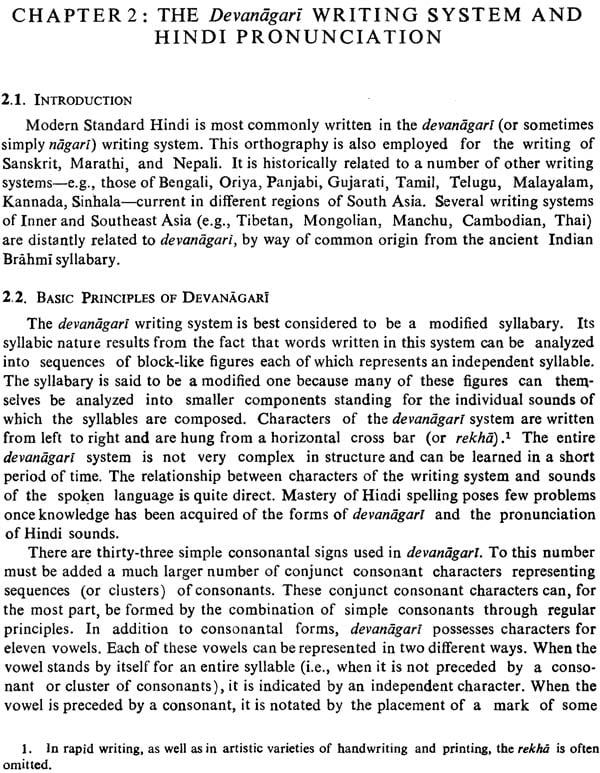
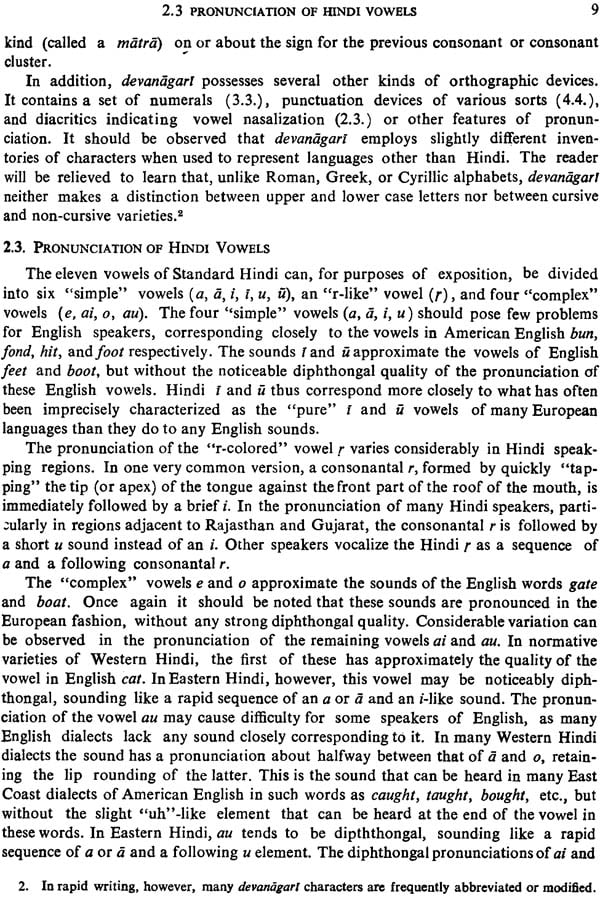
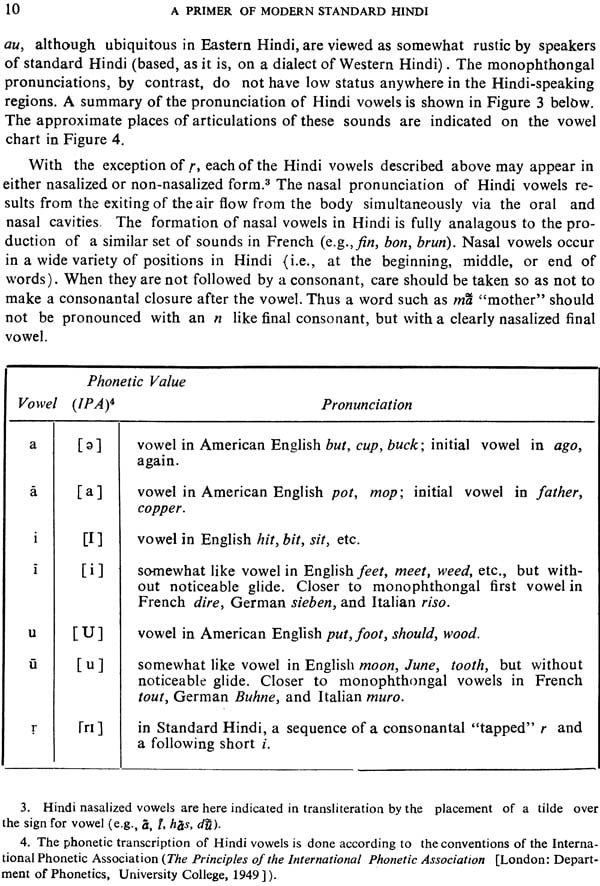
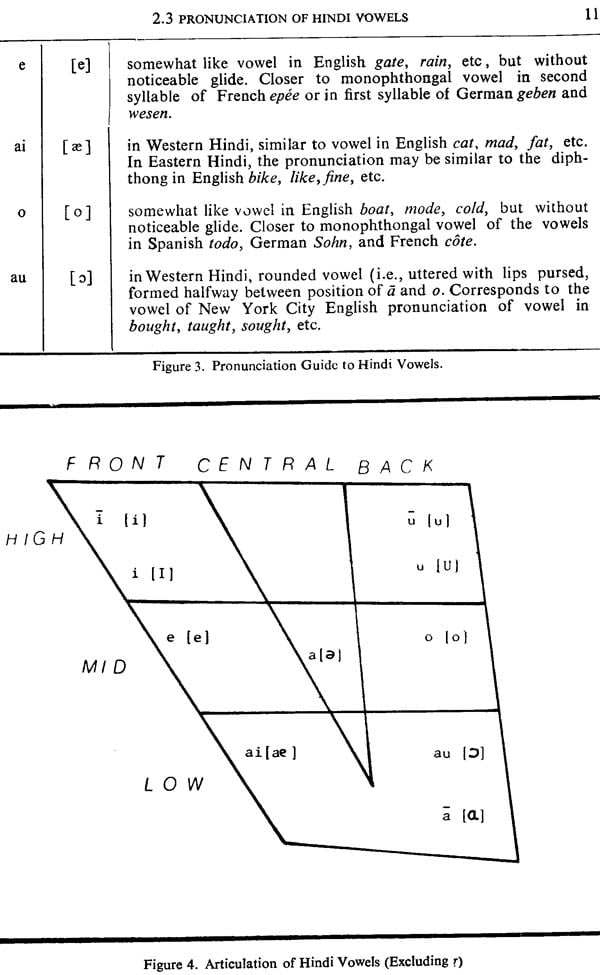
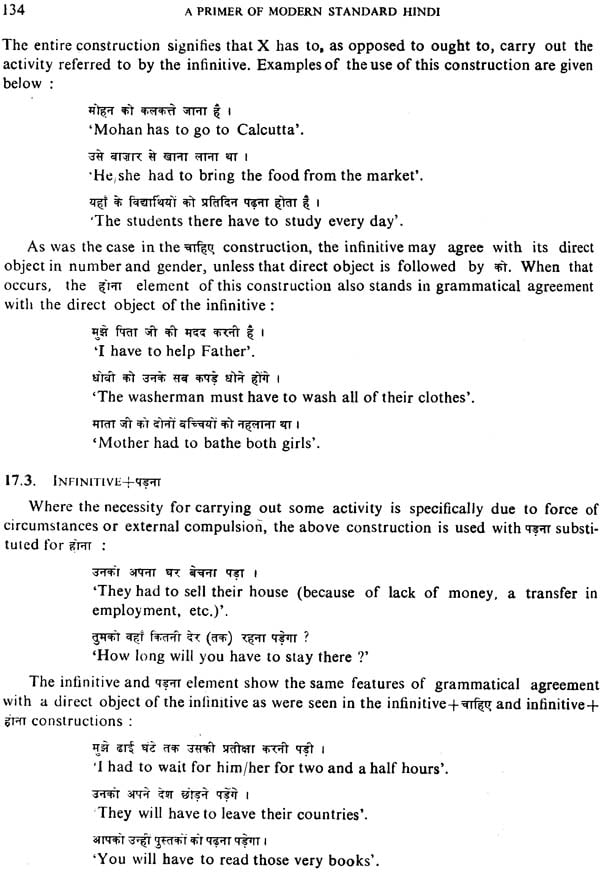

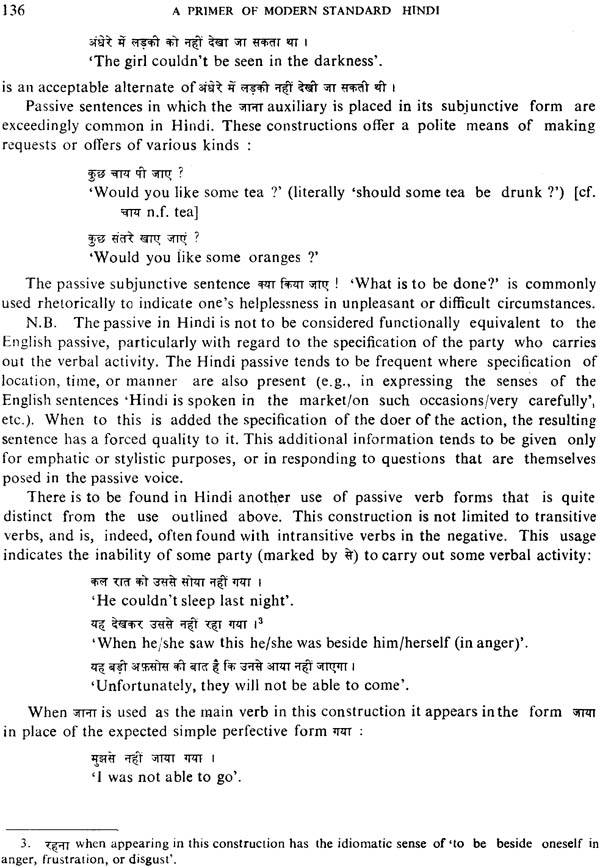
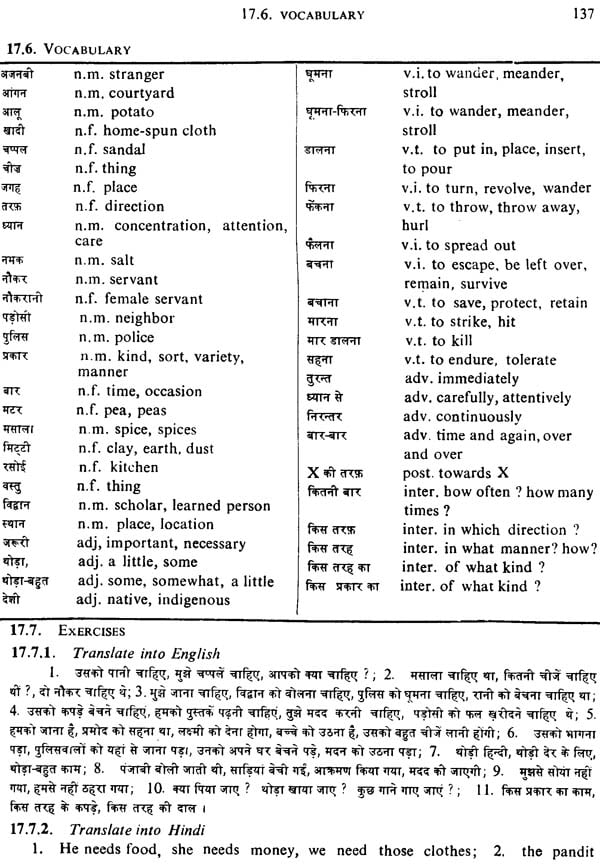

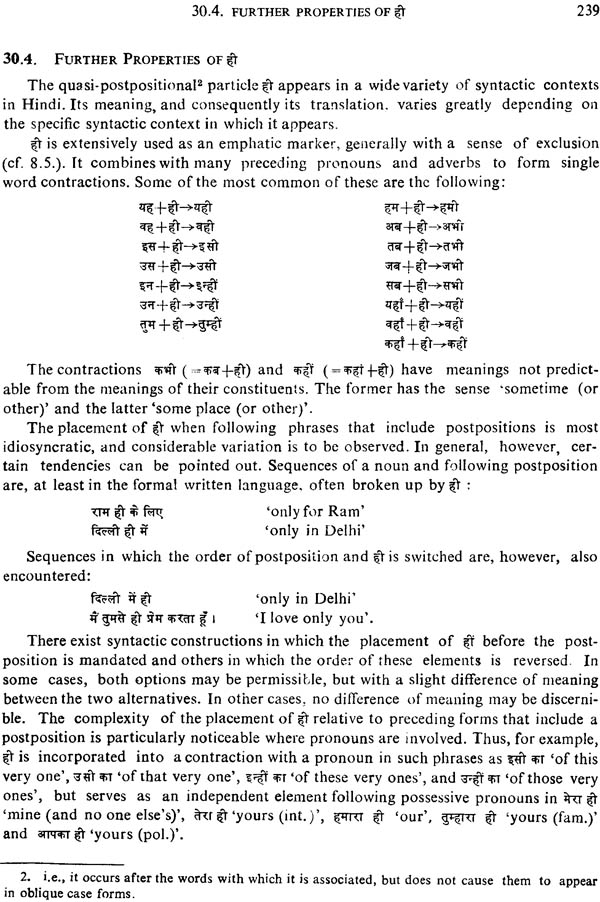
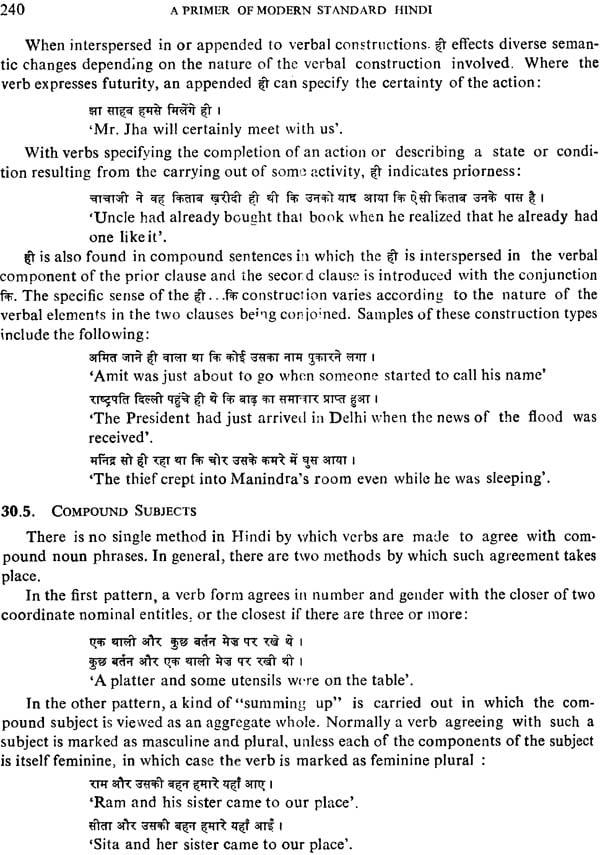
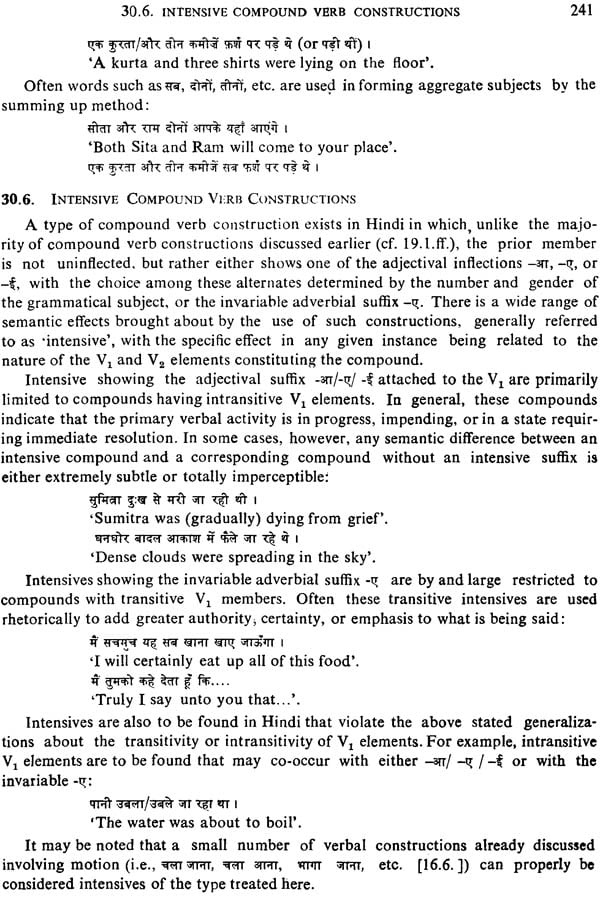
GUIDE TO FURTHER STUDY
HINDI-ENGLISH GLOSSARY
Click Here For More Books on the Hindi Language





